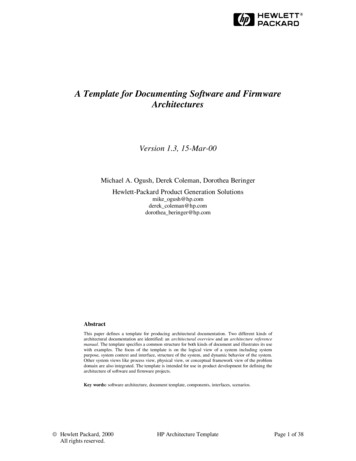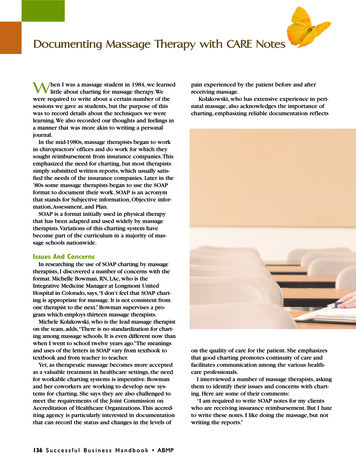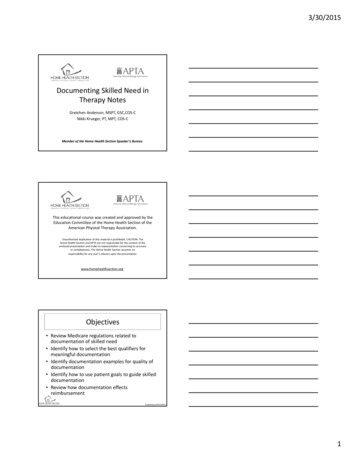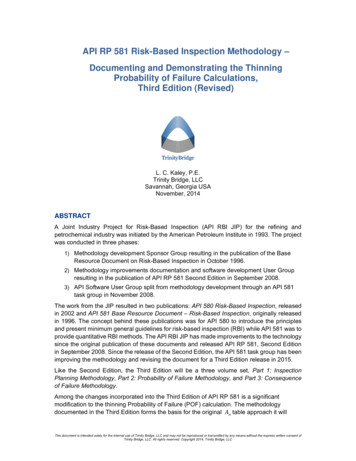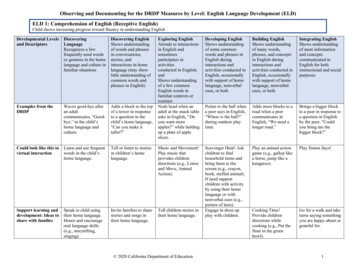
Transcription
Observing and Documenting for the DRDP Measures by Level: English Language Development (ELD)ELD 1: Comprehension of English (Receptive English)Child shows increasing progress toward fluency in understanding EnglishDevelopmental Levelsand DescriptorsDiscoveringLanguageRecognizes a fewfrequently used wordsor gestures in the homelanguage and culture infamiliar situationsDiscovering EnglishShows understandingof words and phrasesin conversations,stories, andinteractions in homelanguage (may showlittle understanding ofcommon words andphrases in English)Exploring EnglishAttends to interactionsin English andsometimesparticipates inactivitiesconducted in English;andShows understandingof a few commonEnglish words infamiliar contexts orroutinesNods head when anadult at the snack tableasks in English, “Doyou want moreapples?” while holdingup a plate of appleslices.Developing EnglishShows understandingof some commonwords and phrases inEnglish duringinteractions andactivities conducted inEnglish, occasionallywith support of homelanguage, nonverbalcues, or bothBuilding EnglishShows understandingof many words,phrases, and conceptsin English duringinteractions andactivities conducted inEnglish, occasionallywith support of homelanguage, nonverbalcues, or bothIntegrating EnglishShows understandingof most informationand conceptscommunicated inEnglish for bothinstructional and socialpurposesExamples from theDRDPWaves good-bye afteran adultcommunicates, “Goodbye,” in the child’shome language andculture.Adds a block to the topof a tower in responseto a question in thechild’s home language,“Can you make ittaller?”Points to the ball whena peer says in English,“Where is the ball?”during outdoor playtime.Adds more blocks to aroad when a peercommunicates inEnglish, “We need alonger road.”Brings a bigger blockto a peer in response toa question in Englishby the peer, “Couldyou bring me thebigger block?”Could look like this invirtual interactionLearn and use frequentwords in the child’shome language.Tell or listen to storiesin children’s homelanguage.Music and Movement!Play music thatprovides childrendirections (e.g., Listenand Move, AnimalAction).Play an animal actiongame (e.g., gallop likea horse, jump like akangaroo).Play Simon Says!Invite families to sharestories and songs intheir home language.Tell children stories intheir home language.Scavenger Hunt! Askchildren to findhousehold items andbring them to thescreen (e.g., crayon,book, stuffed animal).If need supportchildren with activityby using their homelanguage or withnonverbal cues (e.g.,picture of item).Engage in dress upplay with children.Support learning anddevelopment: Ideas toshare with familiesSpeak to child usingtheir home language.Honor and encourageoral language skills(e.g., storytelling,singing).Cooking Time!Provide childrendirections whilecooking (e.g., Put theflour in the greenbowl).Go for a walk and taketurns saying somethingyou are happy about orgrateful for. 2020 California Department of Education1
Developmental Levelsand DescriptorsDiscoveringLanguageRecognizes a fewfrequently used wordsor gestures in the homelanguage and culture infamiliar situationsDiscovering EnglishShows understandingof words and phrasesin conversations,stories, andinteractions in homelanguage (may showlittle understanding ofcommon words andphrases in English)How to supportlearning anddevelopment at thislevel: Ideas forteachersTalk about the hereand now to helpchildren understand thecontext ofcommunication.Encourage adults tocontinue householdtraditions (e.g.,storytelling, familycelebrations) in theirhome language.Exploring EnglishAttends to interactionsin English andsometimesparticipates inactivitiesconducted in English;andShows understandingof a few commonEnglish words infamiliar contexts orroutinesUse language andliteracy activities thathave repetitive phrases(e.g., Brown Bear,Brown Bear, What DoYou See?). 2020 California Department of EducationDeveloping EnglishShows understandingof some commonwords and phrases inEnglish duringinteractions andactivities conducted inEnglish, occasionallywith support of homelanguage, nonverbalcues, or bothBuilding EnglishShows understandingof many words,phrases, and conceptsin English duringinteractions andactivities conducted inEnglish, occasionallywith support of homelanguage, nonverbalcues, or bothIntegrating EnglishShows understandingof most informationand conceptscommunicated inEnglish for bothinstructional and socialpurposesKeep messages anddirections short.Directions should bebroken down intoshort, sequential stepsand supported bypictures, visual cues,and graphic promptswhenever possible.Highlight the manyways families areinvolved in theirchildren’s education.Help childrenunderstand the wordsand sentences in astory. While reading abook, explain themeanings of some newwords and concepts.2
ELD 2: Self-Expression in English (Expressive English)Child shows increasing progress toward fluency in speaking EnglishDevelopmentalLevels andDescriptorsDiscoveringLanguageUses a few “firstwords” or wordlike sounds orgesturesto communicatein home languageDiscovering EnglishCommunicates inhomelanguage ornonverbally, or bothExploring EnglishCommunicatesmostcompetently inhomelanguage,occasionallyusing single wordsor short memorizedsequences of wordsin EnglishChimes in with,“The end!” inEnglish when anadult finishesreading a story to asmall group ofchildren.Developing EnglishCommunicates inEnglish, using singlewords and commonphrases (may mixEnglish with homelanguage)Building EnglishCommunicates inEnglish, using sentencesthat maybe incomplete (maycontain grammaticalerrors and may mixEnglish with homelanguage)Integrating EnglishCommunicates in English,often using completesentences, about a variety ofsocial and instructionalconcepts and topics (maycontain grammatical errorsand may mix English withhome language)Examples fromthe DRDPReaches for orgestures for anobject.Nods, “Yes,” andresponds in homelanguage in responseto a routine questionsuch as, “Do you wantmore milk?” while anadult holds up apitcher of milk.Communicates inEnglish, “I do ahouse,” [“I made ahouse,”] whilepainting.Communicates to apeer, “My dad ride angựa,” [“My dad ridesa” in English; “horse” inVietnamese] whileattempting to draw ahorse.Communicates to a peer, “Iate huevitos [“little eggs” inSpanish]. The huevitos werereally yummy! My papi[“daddy” in Spanish] and me,we get them at la tiendita[“the little store” inSpanish].”Could look likethis in virtualinteractionUse child’s homelanguage.Learn and use keywords or phrases inthe child’s homelanguage.Have a virtualmealtime together.Show and Tell! Invitechildren to share anobject from home withthe class.Invite children to make uptheir own words to theirfavorite song.Communicatewith child usinghome language.Communicate withchild using homelanguage.Read or tell storiesin home language.Bedtime Story! Invitechild to tell you a storyabout their day.Provide multipleliteracy practices,such as readingbooks, singingsongs, andreciting poetry.Allow for wait time toprovide children timeto process informationand respond verballyor non-verbally.Use repetitivephrases (e.g., “It’stime tosing, dance,stretch).Invite children toretell a part of theirday (e.g., What didyou do when youwake up thismorning?).Invite children todraw a picture andask child to tell youabout their drawing.Expand and extendthe child’s language.For example, if thechild says “truck,”the teacher could say,“Oh, you want theblue truck”.Support learningand development:Ideas to sharewith familiesHow to supportlearning anddevelopment atthis level: Ideasfor teachersLook through family photoswith child and take turnstelling stories about thepictures.Ask open-ended questionsand engage in theconversation over a numberof turns. Provideopportunities for the child topractice English (e.g., ask thechild what she did over theweekend or for theirbirthday). 2020 California Department of EducationAct as a total languagemodel. Refrain fromcorrecting children intheir attempts tocommunicate in theirnew language.Provide time for peersto communicate witheach other.3
ELD 3: Understanding and Response to English Literacy ActivitiesChild shows an increasing understanding of and response to books, stories, songs, and poems presented in EnglishDevelopmentalLevels andDescriptorsDiscovering LanguageAttends briefly to afamiliar adult looking atbooks, singing songs, orsaying rhymes in homelanguageDiscovering EnglishParticipates in literacyactivities in homelanguage;andAttends to simpleliteracy activities inEnglish with somesupportExploring EnglishUses home language,gestures, or singlewords in English toshow understanding ofliteracy activities inEnglishExamplesfrom theDRDPUses simple handmovements toparticipate during afamiliar song or rhymein the home language.Joins in with peers whoare singing a song orchanting in child’shome language.Comments in homelanguage about a picturein a book, after hearingother children makingcomments.Could looklike this invirtualinteractionCreate consistentroutines/schedule.Use child’s name toinvite them toparticipate in activities.Read picture books.Wordless picture booksgive the child anopportunity to make uphis own stories (e.g.,Flashlight, Flora andthe Flamingo, MuseumTrip).Provide print materialsbased on children’sInterests (e.g., trucks,dinosaurs, insects,dancing).Supportlearning anddevelopment:Sing and listen to musicin home language.Take a picture walk.Look through books andtalk about the pictures.Draw favorite part of afamiliar story and talkabout the drawing.Make stories comealive. When readingstories use your voice,signs, facialexpressions, and pacingto engage children.Read or tell stories inhome language. 2020 California Department of EducationDeveloping EnglishUses frequently usedwords and short phrasesin English tocommunicateunderstanding about abook, story, song, orpoem told, read, or sungin English (oftenuses actions; may mixEnglish with homelanguage)Repeats the first line of“Five Little MonkeysJumping on the Bed,”with accompanyinghand motions.Building EnglishUses a variety of wordsand phrases in Englishto communicateunderstanding about keyideas of a book,story, song, or poemtold, read, or sung inEnglish (sometimes usesactions; may mixEnglish with homelanguage)Communicates, “Babybear mad! The girl, sheeat it all. Lahat ito!”[“The baby bear is mad!The girl, she ate it all,”in English; “All of it!”in Tagalog] during ateacher-guideddiscussion in Englishabout The Three LittleBears, which has beenread aloud and retold onseveral occasions withprops.Sing songs, recitepoems, clap rhythms,and do finger plays.Integrating EnglishUses elaborated Englishphrases with a variety ofvocabulary andgrammaticalstructures tocommunicateunderstanding of thecontent of a book, story,song, or poem (may mixEnglish withhome language)Communicates to apeer, “Sharks havesharp teeth to bite, andthey swim fast,” whilepaging through a bookabout the ocean.Read for FUN!Encourage children totalk about and askStory Circle! Start astory and provide taketurns adding to the storywith the child (e.g., TheCharacter Puppet!Children can usematerials from home(e.g., paper bags, socks,paper) to create a puppetof their favoritecharacter.4
DevelopmentalLevels andDescriptorsIdeas to sharewith familiesHow tosupportlearning anddevelopmentat this level:Ideas forteachersDiscovering LanguageAttends briefly to afamiliar adult looking atbooks, singing songs, orsaying rhymes in homelanguageDiscovering EnglishParticipates in literacyactivities in homelanguage;andAttends to simpleliteracy activities inEnglish with somesupportExploring EnglishUses home language,gestures, or singlewords in English toshow understanding ofliteracy activities inEnglishDeveloping EnglishUses frequently usedwords and short phrasesin English tocommunicateunderstanding about abook, story, song, orpoem told, read, or sungin English (oftenuses actions; may mixEnglish with homelanguage)Ask families aboutliteracy practices andgoals for their children.Encouraged families toread stories in theirhome language, if theyare not able to read theirhome languageencourage families totell stories orally or readwordless picture books.Incorporate children’shome language whenpossible (e.g., books,songs, videos, poems).Read books severaltimes over a few days. 2020 California Department of EducationBuilding EnglishUses a variety of wordsand phrases in Englishto communicateunderstanding about keyideas of a book,story, song, or poemtold, read, or sung inEnglish (sometimes usesactions; may mixEnglish with homelanguage)questions about thestory.Use read-alouds toprovide explanations fortargeted vocabulary.Integrating EnglishUses elaborated Englishphrases with a variety ofvocabulary andgrammaticalstructures tocommunicateunderstanding of thecontent of a book, story,song, or poem (may mixEnglish withhome language)funniest thing thathappened to me was )Invite children todiscuss and react tostory narratives (e.g.,Who was your favoritecharacter? Has anythinglike this ever happenedto you?).5
ELD 4: Symbol, Letter, and Print Knowledge in EnglishChild shows an increasing understanding of and response to books, stories, songs, and poems presented in EnglishDevelopmentalLevels andDescriptorsDiscovering LanguageDemonstratesawareness that picturesor objects can representpeople or thingsDiscovering EnglishDemonstratesawareness thatsymbols carry meaningor that print in homelanguage carriesmeaningExploring EnglishDemonstratesawareness that print inEnglish carriesmeaningDeveloping EnglishDemonstratesunderstandingthat English printconsists of distinctletters with names inEnglishBuilding EnglishIdentifies severalEnglish letters;andRecognizes own namein English printExamples from theDRDPSees a photo of motherand communicates inhome language,“Mama.”Shows an adult a bookand requests, “Mẹ cóthể đọc cho con nghequyển sách nàykhông?” [“Can youread me this book?” inVietnamese].Points to the printedword “flower” under apicture of a flower andsays, in home language,“That says ‘flower.’”Asks, in home languageor in English mixedwith home language,“What letter is this?”while pointing to thefirst letter of own nameon cubby label.Names four Englishletters correctly whileplaying with magneticletters with a peer.Could look like thisin virtualinteractionPlay Red Light, GreenLight using objects orpictures (e.g., stopsign).Label items in thevirtual classroom.Read books with largetext providing childrenthe opportunity to seeletters.Sing greeting songusing children’s namesin print.Support learningand development:Ideas to share withfamiliesTake a walk downmemory lane and lookat baby picturestogether.Label items in thechild’s environment.Label It! Work togetherto label child’smaterials with theirname.Create an All About Meand My Family book.Child can illustrate anddictate their story to anadult.How to supportlearning anddevelopment at thislevel: Ideas forteachersMake sure that yourspeech matches whatyou are referring to.Encourage adults toread stories or poems intheir home language tostrengthen the child’shome language.Use everydayopportunities to modelattending to letters.Gesture specifically tothe print in theenvironment (e.g., pointto each word and to thefirst letter in each word)Provide access toalphabet letters in avariety of contexts (e.g.,alphabet puzzles,magnetic letters, lettertiles, magazines,homemade alphabetcards).Play letter bingo usingchild’s name. Invitechild to write theirname then put a dot onthe letter in their namewhen called.Name Puzzle! On paperwrite name anddecorate, next cut paperinto puzzle shapes, thenput your name puzzletogether.Point out letter in theenvironment. Hunt forletters around yourhouse, neighborhood oron a drive. 2020 California Department of EducationIntegrating EnglishIdentifies at least tenEnglish letters;andIdentifies a fewprinted wordsfrequently used inEnglishCommunicates to apeer, “Mira, este dice[“Look, this says” inSpanish] ‘s–t–o–p’[using English letternames],” whilepointing to a stop signto a Spanish-speakingpeer.Letter Bingo! Invitefamilies to make aletter bingo board andplay letter bingo withthe class.Using recyclablematerials (e.g.,magazines, newspaper,old mail) make aletters collage.Have clear print inmultiple languages inthe environment (e.g.,posters, pictures, andsigns with print).6
ELD 1: Comprehension of English (Receptive English) . child says “ truck,” the teacher could say, “Oh, you want the blue truck”. Act as a total lan guage model. Refrain from . Attends to simple literacy activities in Englis


